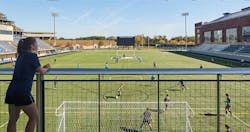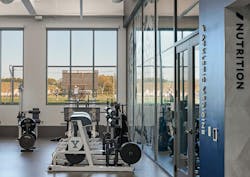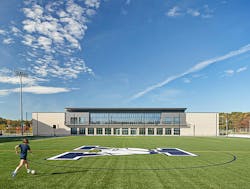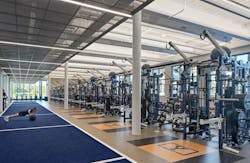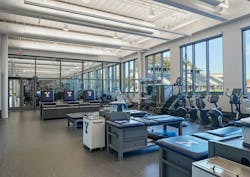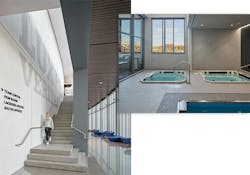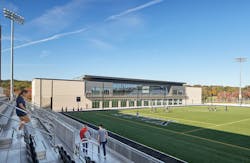How design supports a more holistic approach to training
Many NCAA programs are expressing a desire for a holistic approach to performance—one that thoughtfully integrates nutrition, mental health, sports medicine, hydrotherapy, diagnostics, sleep, recovery, and sport-specific strength and conditioning—all working in sync to improve athletes’ performance in the classroom and on game day.
Training facilities have evolved in response. Over the last decade, the facilities themselves have become a tool to better address the demands of players and coaches. So, how does the built environment fit into this picture? It’s an essential piece of the puzzle. Athletic directors, facility managers, training staff, and designers can enable their athletic facilities to do more for their athletes by considering three key design elements:
- Location, Location, Location
- Transparency: See and be seen
- Interior design: The finishing touch
Location
Historically, sports medicine has been tucked away—often without daylight—within larger athletic facilities. Nutrition has only recently started to be integrated into a student-athlete’s routine over the past five years. Likewise, mental health services, and even having dedicated licensed professionals on staff, is only just debuting on many college campuses.
The weight room has had its glory, and it is undoubtedly a critical part of athlete training and development. But we know now that athletic medicine, nutrition, and mental health services are essential pieces of the puzzle. We must consider all facets of student athlete performance and then co-locate those content areas for efficiency, convenience, and education to encourage the highest and best use of student-athletes’ limited time and energy.
Transparency
Visually connecting these program elements enables athletes to physically see the holistic care they are receiving and instill confidence in their coaching and training staff. Transparency supports team cohesion at all levels of athlete health and performance: Strategic moments of glazing throughout a facility can help to celebrate the moments of physical demand—a new personal record in the weight room—and recovery—a teammate making strides in their injury rehabilitation journey. It can help encourage athletes to use the full spectrum of services, and make the spaces feel more approachable at the same time.
Privacy is of the utmost importance, and this remains unchanged considering the sensitive nature of health and personal development. There are ways to maintain a feeling of openness and welcoming environment while letting students know their individual privacy is not being compromised:
- Strategically incorporate film on glass into an area where some privacy is needed. Bonus: this can be an opportunity for brand activation and culture building
- Provide flexible consultation rooms that can be double as offices or be available for private conversations
- Utilize curtain areas for individual comfort control
- Incorporate translucent materials to maximize daylight where transparency is not appropriate
Views of practice and competition facilities also helps student-athletes visualize their game-day performance during training and injury rehab. Why not celebrate progress, victories, camaraderie by connecting student-athletes and teams visually between interior spaces, between the outside and inside…
The Finishing Touch
Consistency is key. To make an approach to performance feel truly holistic, there should be unity in finishes, lighting, and messaging throughout. The individual spaces should feel like one continuous environment. Interior design will ultimately help tie it all together.
- Finishes such as flooring, tile, paint colors should be the same or closely related
- Equipment and furniture should be thoughtfully selected to enhance the design approach
- Light fixtures and color temperature should relate, while lighting levels should remain appropriate to the tasks and use of space
- A consistent design concept or idea should thread the spaces together
- Brand activation should communicate goals and influence culture
With countless demands on student-athletes, their journeys through preventative and rehabilitative care don’t have to add to stress levels. Top talent demands an atmosphere to support ambitious goals. Parents of recruits respect how a facility will enable their children to be at their best.
Coaches appreciate the efficiency of well-planned treatment and training spaces. For a truly holistic approach to performance include smart adjacencies, visual connectivity, and consistent look and feel throughout.
